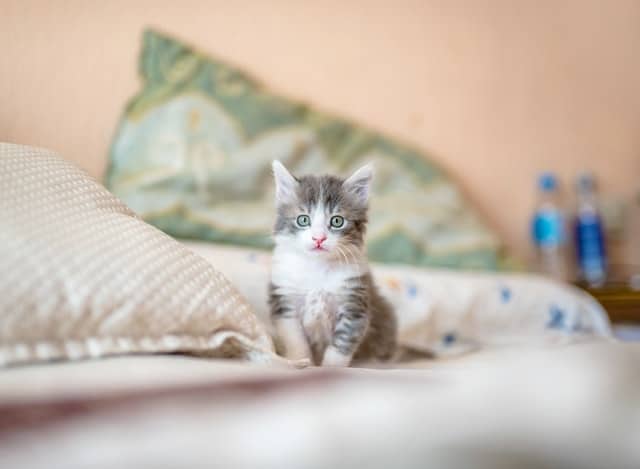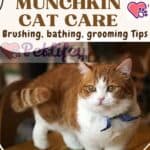Discovering this funny and lively kitten who always wants to play

Munchkin cat is also known as the “dachshund cat”, the Munchkin cat is easy to recognize. It is distinguished by its short legs, the result of a natural genetic mutation. Its tender and slightly funny appearance, combined with a playful character, make up the perfect mix that make it nice at first sight . Its temperament and particular characteristics make the Munchkin cat an irresistible animal in the eyes of breeders and enthusiasts. Let’s see together the characteristics of this cute kitten, still not very common in Italy.
Origin and history of the Munchkin cat
The discovery of the Munchkin cat is American and quite recent.
In a medical diary of 1944 there was already mention of “a black short-legged cat that lived for more than 11 years “, but the official recognition of the breed dates back to a few years ago, as well as its popularity.
It began to be talked about more constantly in the 1980s in Louisiana, where Sandra Hochenedel discovered a short-legged black kitten, immediately called Blackberry. Over the course of her life, Blackberry gave birth to several puppies, half of which had short paws. Toulouse, a male specimen, was born from one of these litters.
And here with Toulouse and Blackberry the foundations were laid to start the breeding of this breed.
In 2003 it achieved championship breed status.
Origin of the name Munchkin
Munchkin refers to the homonymous community of cheerful and friendly gnomes that animate the events of ‘The Wizard of Oz’.
Many nicknames have been given to him: dachshund cat, sausage cat and kangaroo cat.
Munchkin cat: characteristics
The most salient characteristics of these cat breeds are:
- Paws: Distinctive feature, they are particularly short. And more precisely, the front ones are slightly shorter than the rear ones. It is a natural genetic trait, not artificially created in the laboratory.
- Cut: Small to medium-small. It was awarded the title of the smallest cat in the world. It has a muscular build. Females can weigh between 2 and 3.5 kg, males from 3 to 4 kg.
- Structure: Long-limbed, it moves very easily. It has been compared to a ferret.
- Fur: Short in the Munchkin Shorthair, or medium in all other cases, it is soft and silky. The standard admits all colors and any design.
- Head: In the shape of an equilateral triangle and with a thin but not pointed muzzle. The skull is rounded and the forehead flat. The nose is normal, the chin solid and the cheeks well developed.
- Ears: Wide and very straight, they are of medium length and with slightly rounded tips.
- Eyes: Large, walnut-shaped and slightly oblique, they are well spaced. Alive and lively, they come in various colors.
- Tail: It has the same length as the body and is slightly rounded at the tip.
Munchkin cat character
Curious, affectionate and playful. These are its distinctive traits, and it maintains – with perfect coherence to its body – the attitude of a puppy even in adulthood.
Unlike the independent and solitary “prototype” cat, the Munchkin is very sociable. It loves to play and be in the company of others: humans, dogs and cats of other breeds.
Affectionate and cuddly, It loves to receive affection and attention from their owners. It is vital that the Munchkin is welcomed by a family that does not leave him alone all day and, preferably, where there are children.
Although small and a bit clumsy, It has a great need to move. It loves running, climbing and even jumping, but also simply walking on a leash.
Skills of the Munchkin cat
Cat with a thousand resources, it manages to sit on its hind legs leaving the front ones free. The nickname “kangaroo cat” derives from this skill.
Munchkin cat health
Being a fairly young breed, there are no reliable data on specific pathologies.
As proof of this, suffice it to say that some breeders’ associations, such as FIFE (Fédération Internationale Féline), consider it the result of a hereditary disease and that for this very reason it suffers from various ailments.
Many others, however, argue that its characteristics do not represent any limitations and do not make it more vulnerable to certain health problems than other feline breeds.
That said, cases of lordosis , an anterior convex curvature of the spine , are common. The specimens affected by this pathology die at a young age.
How long does the Munchkin cat live
Munchkins can reach 18 years of age.
How to cure the Munchkin cat
It has no special requests. Let’s see the basic attentions.
- general check-up at the vet 1-2 times a year
- brush the fur, clean the ears and trim the nails once a week
The Munchkin is not particularly suited to being let loose. Due to its size it would have great limits to living outdoors. A safe environment, such as a garden, is the right compromise
That’s all. For the rest, lots of affection and desire to play together!
Feeding the Munchkin cat
The ideal diet must privilege wet cat food, prepared with the right proportions of meat and vegetables (maximum limit of vegetable components between 2% and 5%).
Of high nutritional value are the innards such as heart, liver and stomach.
The dry ones, more comfortable for the owners and more tantalizing for our four-legged friend, must represent only an occasional “break from the rule”.
Their low water content can cause kidney and bladder problems.
Where to buy a Munchkin cat
Not very common in Italy and therefore difficult to find in our country. It is in fact a species bred in the United States and France .
However, it is possible to find some reliable breeders here too, but these are truly isolated cases. Virtually impossible to think of finding it at the cattery .
How much does it cost
The price of a Munchkin cat ranges from 300 to 1500 dollars.
If you buy the animal abroad, obviously the cost will increase for the transport and regularization operations on Italian soil and for the quarantine.






